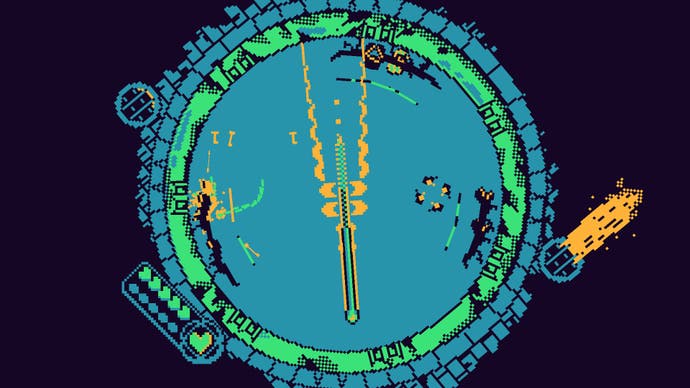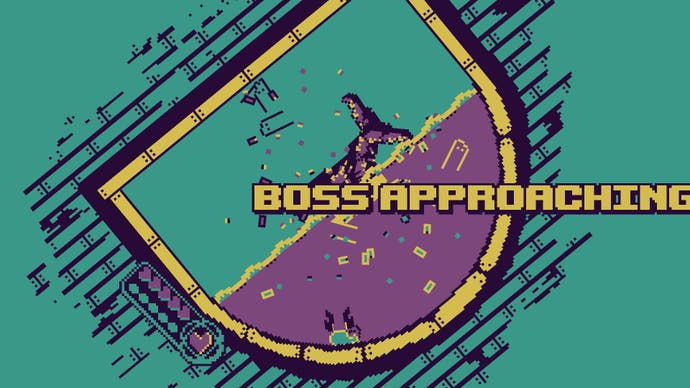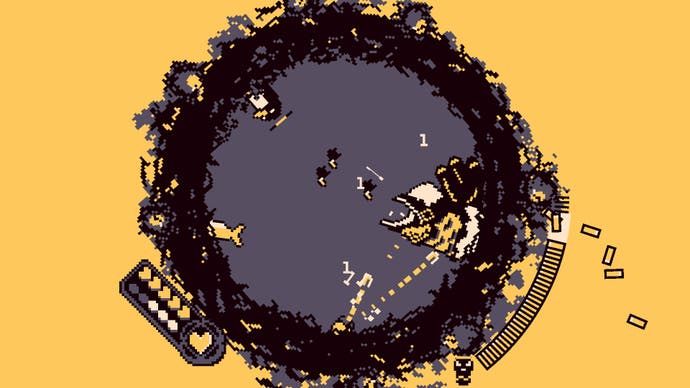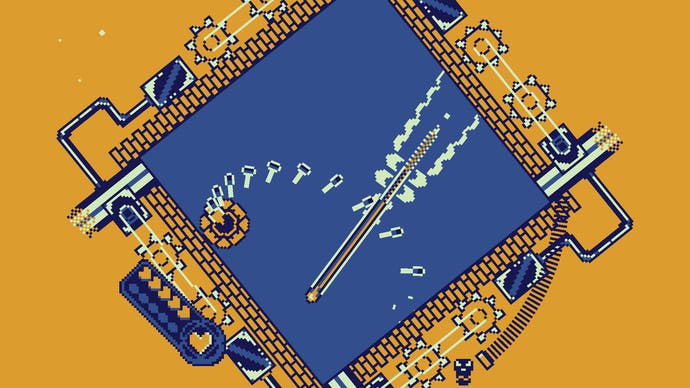Roto Force review - a frantic twin-stick bursting with imagination
Slug life.
Here are some compliments regarding Roto Force that may initially sound like backhanded compliments, but are actually just about the highest compliments I can give. First one. Roto Force is a twin-stick shooter that does not feel like a twin-stick shooter. It feels new and weird and - at first - rather claustrophobic. Rather than being given a whole arena to gad around in, you get the arena but are stuck to its inside walls. So you can do loops, left or right, aiming at spawning horrors that bubble within, but they get most of the freedom. This may seem unfair - all that space for the baddies, yet it's out of bounds for you. Not so. You can also use a trigger to dash across this space, aiming a straight line from one part of the wall to another. This is so quick it feels almost like teleportation. It's great and there's loads of nuance to how it works.
Second one. I gather Roto Force was born in a game jam, and the finished game has retained that jammy energy. It's polished and brilliantly conceived, but it has the headlong pelt and brisk enthusiasm of a sketch, something dashed out on paper and surprisingly, improbably brilliant. I reckon retaining that level of energy when you take something small and turn it into something a bit bigger is incredibly difficult. Roto Force has made the transition beautifully. It's a lovely bit of craft, but it also has that mania to it of something that has flung itself together at deadly speed.
Third one. I realise now that I didn't actually see much of Roto Force on my first playthrough. I don't mean I skipped bits or missed entire levels. It's just that the whole thing is so fast, so frantic, that my poor addled brain could only respond on the level of mechanics. I learned how to distinguish bullets I could dash through safely from bullets that would still harm me mid-dash. I learned how certain enemies and even power-ups come with little bubbles that make them immune to firepower and must first be hit with that dash. I learned that you can shoot the checkpoint marker that spins through the game after each round and it will then spawn a weapon selector so you can change things up for the next furious blast of action. I learned how some enemies swarm while some stick to the walls to stop you from ducking everything by mindlessly racing about. All of this I learned, but I didn't see much. It was gone in a friendly blur.
I have been back in now and I can tell you that Roto Force is as visually ingenious as it is hectic. We're in the world of Game Boy Player 8-Bit here: four colours and chunky, deckle-edged sprites. You play a sort of slug thing, I think, and enemies come in all forms and drawn from many worlds. There's a level where it's all about birds - penguin guys spawn and lob fish (?) at you, while the boss fight takes place in a nest. There's a level that's all about...slime...I guess? In which plants erupt from soil and fire out toxic gas and the boss is this sort of bubble of goop who emerges from the wall itself and chases you around.
Those are just early levels. Go on and you'll find sand worms erupting from the dunes of a desert that used to be a museum, and a triangular city of electricity where you blast away at light bulbs and plugs. It's so fast, so deadly, so punishing - and so creative! It reminds me a little of the marginalia on old medieval documents, those tiny drawings that are initially hard to see in amongst all that text, but which, when successfully tuned into, will reveal an upside-down world of three-headed kings and devilish rabbits. Like marginalia there's a strange wit to the creatures Roto Force conjures: the more you look, the more there is to see. Unlike marginalia, though, all of this stuff can kill you.


And in amongst the visual chaos there's so much to learn. When to dash. When to do the super dash move that is charged by excess health and allows you to damage any baddies you hit. How best to position yourself to chug away for a multiwave boss or a devilish mini-boss. Pay attention to the changing shapes of the arenas you roll around: you can find yourself on the wrong wall and unable to hit your current target. Ignore the changing colour schemes that are there to dazzle and unsettle. Focus on what's trying to kill you, on what's sticky and stopping you from moving all of a sudden, and on the empty space that means something new is looming.
It would be too much, I think: a twin-stick that shoves you into a food processor and clamps down the lid. But it's broken up into waves and there's a generous checkpoint system. Also, each level gives you a new weapon to choose from. And here Roto Force started to remind me of Treasure, of all developers. Gunstar Treasure, where each weapon is both a new toy and - in a way - a new difficulty level.
There's wild ingenuity to the weapons you unlock, and they each require learning. You don't just learn the controls, which often change from one weapon to the next, but you also learn how best to truly make the most of this new gadget you've been given, which at first can leave you unmoored in a game you suddenly don't understand anymore.



The main weapon - I think it's the first one anyway - is a rapid shot. It's quickly joined by the option to switch to a homing shot, which moves more slowly and also won't hit certain enemies with shielding in certain places, and a ricocheting shot which can be charged and released and leads to vibey disco carnage when all these straight laser lines are suddenly bouncing off the walls in unlikely ways. Moving on, there's a bomb which can bounce, and which sees you holding down the trigger until you want it to explode, and there's stuff like the helix short and the electrical charge and the flame whip. The last of these is great: real power coupled to a short reach. It's pure Treasure.
Marginalia, food processors, the Treasure back catalogue. Roto Force is one of those games that challenges you to understand its various moods and components. Ultimately, though, it left me thinking of one of those Jack-in-the-box toys, tightly wound up and squeezed into this impossibly small space. And then you press the big red button and everything erupts outwards.


